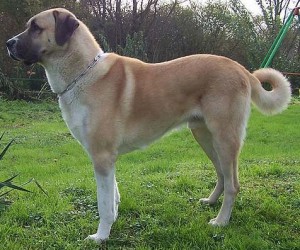 The Anatolian Shepherd Dog, also referred to as the Anatolian Karabash, is a large dog breed that originated in Turkey. They were bred to guard sheep herds on the Anatolian plateau in Turkey. This breed can grow up to 30 inches tall and can weigh up to 150 pounds. They have a double coat. Their undercoat is thick and dense and their overcoat is short. The most desirable coat colors for this breed include cream and fawn with black face masks. However, this breed can come in just about any color combination.
The Anatolian Shepherd Dog, also referred to as the Anatolian Karabash, is a large dog breed that originated in Turkey. They were bred to guard sheep herds on the Anatolian plateau in Turkey. This breed can grow up to 30 inches tall and can weigh up to 150 pounds. They have a double coat. Their undercoat is thick and dense and their overcoat is short. The most desirable coat colors for this breed include cream and fawn with black face masks. However, this breed can come in just about any color combination.
This is a very intelligent dog breed that loyal and protective. They get along with children as long as the children are a part of their family, or as long as they have been introduced to the dog. Their instincts for guarding sheep can be easily translated to protecting your home and family. Because of this and their size, they make a great guard dog and watch dog.
To care for this breed you will need to brush its coat daily to keep it clean and tangle free. This dog needs a lot of exercise and large areas to run around in freely. Because they are an intelligent breed they also need mental stimulation as well to stay happy and healthy. If cared for properly they can live up to 15 years.
The Anatolian Shepherd Dog is a large and powerful dog, and as such is not suited for everyone. They have bred for thousands of years in Turkey as livestock guardians for the flocks of semi-nomadic shepherds. Their natural foes included wolves, bears, and wild boar.
It is probable that dogs of this type existed 6,000 years ago in Mesopotamia. The dogs were probably called Coban Kopegi (shepherd dog), and over the centuries, regional variations developed.
Large, rugged and impressive, they possess great endurance and agility. These dogs are tall and powerful, yet not massive in build. The breed is regarded as a flock guardian of the mountain molosser-type belonging to the mastiff family. They are capable of reaching speeds of 35 miles per hour or greater. Their agility coupled with endurance helps them to run down predators with relative ease over great distances.
 The Anatolian Shepherd has an intelligent expression and wide-set, dark brown, almond-shaped eyes. The ears are approximately four to six inches in length, V-shaped, rounded at the tips and rest on the sides of head. The muzzle has a sturdy, strong appearance and the nose is either brown or entirely black.
The Anatolian Shepherd has an intelligent expression and wide-set, dark brown, almond-shaped eyes. The ears are approximately four to six inches in length, V-shaped, rounded at the tips and rest on the sides of head. The muzzle has a sturdy, strong appearance and the nose is either brown or entirely black.
While not a “glamor” breed, the Anatolian’s loyalty, independence and hardiness is cherished by breeders and owners. The Anatolian Shepherd is a very dependable, alert and possessive dog. It is intelligent and easy to train, but is not a dog for beginners. It needs a handler who naturally radiates leadership.
Keep in mind, time and effort is required to keep Anatolians socialized and well-behaved. They are very strong and can be very stubborn at times. If you are looking for a dog that will obey at the drop of a command, then this is not the dog for you. The owner should not allow commands to be given unless an effort is being made to follow through should the dog elect the typical reaction of “selective deafness”.
Anatolian Shepherd Dogs are wary of strangers. Therefore, socialization is a must. This is best done in a pup’s early months. Obedience training should begin as early as possible, as well, due to this dog’s immense size. Firm, consistent training as a youngster will prevent an out-of-control, massive dog that tries to show dominance over its master.
The Anatolian Shepherd Dog has two different coat varieties short and rough. The short coated variety possesses a short, dense coat in solid colors ranging from cream to fawn, with a black mask and ears. Be prepared for the extremely heavy seasonal shedding that typically accompanies undercoated breeds. During this time, the coat will need to be brushed frequently. Otherwise, the Anatolian Shepherd Dog coat requires very little care.
As with any deep-chested dog, the occurrence of Bloat or Gastric Torsion is a real possibility in the Anatolian Shepherd. If you are not familiar with these conditions, it is absolutely necessary to learn about them and know the symptoms. These conditions can cause real life threatening conditions that will require emergency Veterinary attention.








17 Responses to “How to Train an Anatolian Shepherd”
Hi, I got my Anatolian/ St. bernard mix and hes a little older than a puppy. 2-3 years old. He keeps pottying in the house, wont go up stairs and he never comes when i call. i grew up with a rottweiler but he was a puppy when we trained him. He wont even go on a walk on the leash. he wont leave the property which concerns me.
Hi Alicia,
For potty training: make him look at what he has done (no need to say anything). Pick it up with a tissue or plastic bag (not a scented doggy poo bag) whilst he is watching and take it and him outside. Put it down where you want him to go in future and make sure that he sees it. If you catch him going in the house after that, a loud “hey” to give him a shock should do the trick.
For the stairs don’t try to force him or try to coax him to go up. You have obviously tried this without success and every failure will reduce your status as leader in his eyes. Try leaving a treat on a step just out of his reach and leave him to it. If he takes it then next time put the treat higher up.
For the recall, don’t call him until you can be sure that he will come to you, otherwise you are just teaching him bad habits. The way to train him to come is to have him on a slack long lead when you call him. If he doesn’t respond give the lead a jerk to nudge him in the right direction. Another thing you can do is to start moving quickly backwards to encourage him to come to you, but keep the lead slack. When he arrives make a big fuss of him. Keep practicing several times a day until you can be sure that he has “got it”.
For leaving the property, take it in slow small steps. Maybe step one would be getting him to stand at the door (but still in the house) with the door open. If he is nervous of people or traffic, choose a quiet time. Wait until he is relaxed then praise him lavishly. Practise this several times before moving on to the next step, which could be doing it at a slightly busier time or standing in the doorway. Then one step outside. Make the steps as small as you and he need so that he doesn’t go into panic mode and you don’t fail. Once you decide on a step keep persisting until it is achieved and in the next session repeat the same step until it is easy before moving on to the next step. Failure is a setback, it is better to build on success.
Hi, I just got an Anatolian Shepard mix. He is 1-2 years old. He is good with children, and people though he doesn’t listen well. It seems like when he gets infatuated with something like a bunny or deer or other dog, he gets in this zone and he doesn’t listen and if hes off a leash he just takes off. I live in the forest and I would like him to be able to roam around my property but every chance he gets off the leash, he takes off and I spend the whole day searching through the woods to find him. I’m also a little concerned cause I want him to be a guard dog but whenever a stranger or dog comes on the property or in the house, he doesn’t bark and often doesn’t even notice someone else is around.
When someone says ‘My dog doesn’t listen’ my first question that I ask them to ask themselves is ‘What have you done to train him to listen?’ Have you taken the time to teach him to come when called? Have you checked out the various articles and videos on the site about training your dog to come when called?
You need a good fence. I have a hog wire fence around my property and it keeps Dusty in. An electric fence is useless on them. They will figure out the weak spots or just get up some speed and go right through them.
Have a nice days,
I regret to say that most of the dogs that called “anatolian shepperd” in Europe and USA are not pure blood.
As a 2 Anatolian Shepperd owner,I can easliy say that,they are not suitable for training because of their character.The best thing you can do is show them respect with love.Then you can gain massive guardian for your house or livingstock with huge loyalty.
As a former guard dogs (El Presa Canario,Rottweiler,English Mastiff) owner I may give some hints about Anatolian Shepperds
Hints ;
+They need big areas,if you chained them you can easily see hip displecia problems if you haven’t got enough place,45 minutes daily walks mandatory for their health
+Never shout to them too loudy or “warning slap”.They are too clever and can get its revenge when you need it. (In Anatolia there is a lot of tales that Kangal Dogs’ revenge)
+They really like tough love,if you can wrestle with them,they can really be happy
+They know how strong they are,so be careful,it is not a suitable dog for all kind of people
+Kangal dogs are protective dogs.In a family they see only one person as a owner and the rest is “stock that must be protected”.But the important point is,Kangal can test its owner’s lordness anytime anywhere.If you loose this test it is really hard to gain back its loyalty.
If you can implement these points with your Kangal dog, you never need to lock your car,motorbike or garden door because there is Kangal dog which protect you till its death
I agree, I have one that my nephew sent me from Iraq. He was part of the No Pup Left Behind program. I wasn’t too sure about him when he arrived but now he is part of the family. And you are right, they can’t be trained and really shouldn’t be. After I introduce someone or another animal to Dusty he is fine with them. Very gental. Asa mater of fact, my wife’s pomeranian bosses him around. And he’s great with my cattle. That being said, woe be it to anything that come into HIS yard he doesn’t know.
But they are very aloof but thats OK.
I have an Anatolian Shepherd/St. Bernard mix. I keep reading that they are untrainable. I have had my Bella since she was 8 weeks old. She’ll be one year in May. She’s been the easiest dog I’ve ever trained! She’s so smart! Now she is very stubborn but so am I, I guess I have no problem waiting it out and making her do things. Maybe it’s the amount of time I’ve put into stimulating her brain? She loves people, but knows when no one is suppose to be in the house. She’s leash trained and gentle with smaller animals (I have a rabbit). She is VERY intelligent but maybe the constant learning of new tricks and taking her to new places to learn has kept her happy and her brain stimulated. So I wouldn’t say they are unsuitable for training, because Bella has done amazing with the expectations I’ve given her. I also agree that try know how strong they are, she has tested me a bit. But has never been able to win. I just wanted to throw out there that not all of them are unsuitable for training. Taking lots of time to train is so important while they are little, and keeping their minds stimulated and healthy while they grow!
Great work. Glad to hear you’ve been having success.
Where are you reading, though, that these dogs are untrainable?
The comments above people are saying you shouldn’t try to train them. I just disagree with that.
I totally agree… I have a 7-month-old Anatolian that i am not sure what she is mixed with, if anything. She has the shorter coarser coat. She is great with commands from waiting for the “ok” to eat, as well as her many tricks, and her love of fetching her tennis ball. The only problem i have, is to get her to beave on a leash. Would you have any pointers how to get her from dislocating my shoulder each time?
I have a shorter leash for Bella. We don’t go out the door until she is ready for commands. I keep her very close to me until she stops trying to pull and stays at my side. i also have a halter for her, its easier for me to control her if shes being naughty and trying to jerk a lot. Consistency and reminding them they can’t get away with being a brat has really helped me. It’s taken a while to get where we are at. they definitely are stubborn dogs, but I’m even more so than she is. I’m going to go through a good dog training in Aug. with her. I feel if someone can help train me on how to train her we’ll have even more success. She is a good dog, just extremely smart and stubborn as well as big. She’s just over one now and weights about 150lbs. That’s a whole lot of puppy :0)
Hi there, my friends have recently adopted an anatolian mix from the shelter and I met her yesterday. I let her greet me and all was well most of the day. My friends mentioned she has reacted “defensively” or guard like before to other people she has met. She was good with me and did not growl or act out, however that did not last. Im not sure how i trigger her reaction but she barked and went into a guard posture. I reacted by raising my voice and trying to display my place (not sure if that was the right move). The rest of the day she generally avoided me and would lay in front and growl at me. So what im wondering is this normal for the breed or does she have developed fears from past owners? What corrective actions should me friends take? Thanks for reading and I would appreciate any advice. Cheers
My Anatolian is 7 months old and has gotten in the habit of barking at night. Only after all house lights are turned off and all is quiet in the “neighborhood”. First couple times I locked her in kennel and she whined for a bit but was quiet the rest of the night. Then, she became impossible to kennel. The ‘tag” game began every night trying to get her in there. (This is also where she eats and there is no problem getting her in at meal time). Now we use a “bark” collar. After just two nights, she became impossible to catch to put the collar on…
I’m pretty sure she is barking because she see’s coyotes in the next pasture but it’s non stop after the sun goes down unless I can manage to kennel or collar her. Any suggestions how to stop the barking? I don’t like to lock her up at night because she’s supposed to be protecting the sheep…
Is she getting some good, solid exercise before bed?
We acquired an Anatolian Shepherd from a rescue in January 2013. They estimated she was 2 years old at the time. We have no background info on her. For the first 6 months she had terrible separation anxiety and she could not be left alone. When I had to get out of the house, I took her to doggie day care for 2-3 hours/day 3 times per week. I worked on her separation anxiety and she is now able to stay home for 4-5 hours at a time. The problem now is she has started to become somewhat dog aggressive. Out of ten situations, there will be one or two that does not work. She got 86′d out of doggie day care, and we no longer take her to dog parks. She has also started barking at the gardener (from inside the house when he runs the blower around the patio doors, etc). I use a pinch collar now when I walk her because she weighs more than I do. She is very sweet and loves people. I used to train in AKC obedience, so I have worked with her to sit, down, stay, come on command, however, I would not trust this dog off of a leash. Any help or advice would be appreciated.
I have a some experience with the breed and currently own a very stubborn 8 month old male Anatolian. I love him to death but he can be the biggest pain sometimes. Some of it is probably because he is intact (growth plates don’t close on them till 1yo) and they are slow to mature. He’s currently well over 100lbs and almost 32in at the shoulder. I used to use a pinch/prong collar on him but I would entirely advise against it. Get a gentle leader for the dog. It gives you total control over the dog and will not reward pulling. Plus, if on correctly, the high position it sits on the head/neck pushes on the same nerve mom touches when they are carried as puppies. Within 10 mins the dog will calm. It has worked wonders while training for ours.
He passed his beginning training easily with the help of the gentle leader. Before the collar and training he had developed fairly bad animal aggression. Our other dog was very protective so I think that had an effect on him as he took her lead from about 8 weeks on.
Anyway, anyone who says they can’t be trained should not own a dog like this. They can be incredibly strong willed and are powerful, dangerous even without showing them their place through firm positive training. This is a dog that can often clear 6 foot fences, weigh over 140lbs, and run around 35mph for a good amount of time. They can dominate a person. You owe it to them as a responsible owner to train them. With that training, you get a giant breed that lives up to 15 years, is discerning of people, tends to LOVE children, and will defend house and home with their life.
I’ve owned or fostered 5 of these so far and they are a truly special breed. You just have to be willing to put the necessary energy and time into their care and training. They typically aren’t born bulletproof and easy going like a golden retriever.